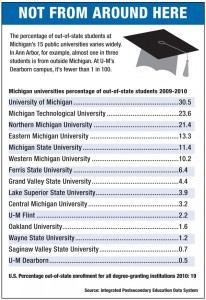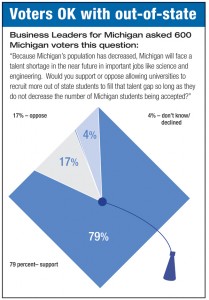Universities eye out-of-state budget help
Faced with tight budgets and prospective dwindling in-state enrollment, public universities across Michigan are looking beyond the state line for answers.
One option, say advocates such as Domino's Pizza CEO Patrick Doyle and University of Michigan President Mary Sue Coleman, is to boost recruitment of out-of-state students – students who pay much higher tuition rates than the Michigan natives sitting next to them in class.
"As a state, if you look at all 15 universities, we are underperforming in terms of our out-of-state student population," Coleman said in May at the Mackinac Policy Conference. "That is, we have capacity, and these students come paying the full freight. They actually add tremendously to the economy in the state of Michigan."
For months, Business Leaders for Michigan -- a nonprofit advocacy group of business executives and education officials aimed at strategies to grow the state economy – has argued for an "out-of-state" recruitment strategy. It estimates that raising Michigan’s out-of-state enrollment to that of comparable universities outside the state could net $200 million in increased tuition over four years.
That’s a huge deal for university administrators and parents alike. State investment in university operations has dropped significantly in the last decade. For fiscal 2001, the state appropriated about $1.9 billion in state funds.
Had that level been maintained for 2012, the state investment would be $2.46 billion, adjusting for inflation. Instead, state funds for the 2012-13 budget are just over $1.3 billion.
But out-of-state students have value beyond their wallets, BLM argues. They serve a second, more vital, purpose: boosting a university talent pool that could prove thin if current enrollment patterns continue.
Such ideas are attractive to a vast majority of Michigan voters, BLM has found. Via polling conducted at the end of August, BLM found that 79 percent of Michigan residents supported more recruiting of out-of-staters, as long as such additions didn't limit the number of college slots to Michigan students. Only 17 percent expressed opposition to the idea in a survey of 600 voters by The Glengariff Group.
"BLM sees our higher education system as one of the state's most important assets in growing our state’s economy," said Kelly Chesney, BLM vice president. "It’s no secret that Michigan is facing talent shortages in the future. Many of the jobs of the future will require a post-high school education -- tech training, community college or better.
"Michigan’s premier higher education institutions can be a part of the solution. With K-12 enrollment on the decline, increasing out-of-state enrollment at Michigan’s universities without adversely impacting in-state enrollment can help fill the talent pipeline," Chesney added.
The number of Michigan's high school graduates could drop from 117,750 students in 2008 to 91,870 by 2020. The 2010 Census found that the number of children under 18 in Michigan dropped by nearly 10 percent in 10 years, a decline of more than 250,000.
Analysts attribute that to falling birth rates and families that fled the state during the recession.
The tuition rate differential between in-state and out-of-stae is considerable. At U-M, 2011-12 tuition and fees were pegged at $12,634 for in-state undergraduates and $37,782 for out-of-state undergraduates. At Michigan State University, in-state freshmen were charged $406.75 per credit hour in 2011-2012 compared to $1,038.25 for out-of-state residents.
But at the same time, the enrollment profile varies widely among state universities. The University of Michigan had out-of-state enrollment of more than 30 percent in 2009-2010, according to the Integrated Postsecondary Education Data System. Michigan Technological University was second with 23.6 percent, Northern Michigan University third at 21.4 percent. All ranked above comparable peer institutions.
Several schools – including Wayne State University, Oakland University, Ferris State University, Grand Valley State University, Saginaw Valley State University, U-M Dearborn and U-M Flint -- had out-of-state enrollment of less than 5 percent. In each case, they were far below peer institution averages.
In 2010, the U.S. average out-of-state enrollment at all degree-granting schools was 19 percent. Michigan's, going to Coleman’s point above, was 9 percent.
“Michigan State University has recruited and welcomed domestic and international out-of-state students and scholars for over 100 years to enrich the diversity of our learning environment for all of our students,” said MSU Provost Kim Wilcox. “Because of MSU’s longstanding commitment to international teaching, research and outreach, we are particularly attractive to a broad range of students — and able to make those students feel like they’re a vital part of our campus community.”
The issue has a touched a nerve beyond the Great Lakes State. In California, a legislator is backing a constitutional amendment that would limit out-of-state enrollment in the University of California system to 10 percent. UC-Berkeley Chancellor Robert Birgeneau said the measure would do "irreparable harm" to Californians and hamper institutions such as UC-Berkeley, where out-of-state enrollment was 18 percent in fall of 2011.
Officials at Wayne State University (1.2 percent out-of-state for 2009) say they aren't interested in boosting nonresident numbers.
"Michigan taxpayers are providing funding to us to help the students of Michigan," Robert Kohnman, the associate vice president for budget, planning and analysis at WSU, told the Detroit Free Press.
But in North Dakota, strategies to boost enrollment by out-of-state students are judged a success. Out-of-state students comprised more than 50 percent of the 14,500 enrolled in 2011 at North Dakota State University, as well as at the University of North Dakota in Grand Forks. Nonresident students at North Dakota's 11 public colleges constitute a higher ratio than in almost every other state. With a population of about 684,000 (in 2011), North Dakota has a public campus for every 62,181 residents.
University of North Dakota Chancellor William Goetz noted that nearly 50 percent out-of-state and foreign students remain in the state after graduation.
At Grand Valley State University in West Michigan, graduate student Andrew Bradley, 25, said he believes a larger mix of students from outside the state "could foster a good, healthy competition" at GVSU.
"You would be attracting new talent. I'm all for it if it can do that."
Ted Roelofs worked for the Grand Rapids Press for 30 years, where he covered everything from politics to social services to military affairs. He has earned numerous awards, including for work in Albania during the 1999 Kosovo refugee crisis.
Michigan Education Watch
Michigan Education Watch is made possible by generous financial support from:
Subscribe to Michigan Health Watch
See what new members are saying about why they donated to Bridge Michigan:
- “In order for this information to be accurate and unbiased it must be underwritten by its readers, not by special interests.” - Larry S.
- “Not many other media sources report on the topics Bridge does.” - Susan B.
- “Your journalism is outstanding and rare these days.” - Mark S.
If you want to ensure the future of nonpartisan, nonprofit Michigan journalism, please become a member today. You, too, will be asked why you donated and maybe we'll feature your quote next time!




